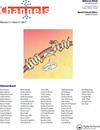Sec61: A static framework for membrane-protein insertion
IF 3.2
3区 生物学
Q2 BIOCHEMISTRY & MOLECULAR BIOLOGY
引用次数: 5
Abstract
During their synthesis at the ribosome, many proteins have to be either translocated across or inserted into the endoplasmic reticulum (ER) membrane by the translocon, a multi-subunit complex located in the ER membrane. The universally conserved protein-conducting channel Sec61 forms the functional core of the translocon. Accessory translocon components, most notably the stoichiometric translocon associated protein complex (TRAP) and the near-stoichiometric oligosaccharyl-transferase (OST) complex, complement Sec61 and assist in protein transport and membrane protein integration or facilitate maturation of nascent chains by covalent modifications. Early characterization of Sec61 by conductance measurements indicated that it adopts at least 2 distinct conformational states to enable protein translocation and membrane insertion while preventing extensive ion flux: a moreconductive state when bound to the ribosome and a less-conductive state upon ribosome release. Sec61 is a hetero-trimeric complex, consisting of the central Sec61a subunit and 2 much smaller peripheral subunits, Sec61b and Sec61g. X-ray crystallographic analyses of prokaryotic Sec61 homologs revealed that Sec61a consists of 2 pseudo-symmetrical Nand C-terminal halves, each comprising 5 transmembrane helices, which form the translocation channel. The two domains are connected by a short ‘hinge’ helix allowing a jaw-like motion of the Nand C-terminal halves with respect to each other. Consistent with the early characterization of the protein-conducting channel, Sec61 was found to adopt 2 functionally different conformations: a state with a lateral opening between the 2 Sec61a halves, which allows hydrophobic helices to partition into the lipid bilayer (termed the lateral gate), as well as a laterally closed state (Fig. 1). Recent mechanistic models for the interplay of the ribosome and Sec61 were derived from single particle cryo-EM structures of ribosome-bound, detergent-solubilized Sec61 in distinct functional states. They suggested that ribosome-bound Sec61 is mostly present in a closed state and opens only transiently for integration of a nascent transmembrane helix into the membrane. However, these models were inconsistent with the earlier conductance measurements, which indicated that ribosome binding alone induces conformational changes of the native protein-conducting channel toward a more conductive state. This discrepancy illustrates the need for visualizing the conformation of ribosome-bound Sec61 in a lipid environment and in presence of all other translocon components. Cryo-electron tomography (CET) in combination with subtomogram analysis is an excellent method for studying the structures of large macromolecules in their natural environment. It is particularly attractive for studying membrane-embedded and –associated complexes, because detergent solubilization is not required, avoiding destabilization of the complex during purification. Developments in direct detector technology, automated tomographySec61:膜蛋白插入的静态框架
在核糖体合成过程中,许多蛋白质必须通过易位子(位于内质网膜上的多亚基复合物)跨膜易位或插入内质网膜。普遍保守的蛋白质传导通道Sec61形成了易位的功能核心。辅助转座子成分,尤其是化学计量的转座子相关蛋白复合物(TRAP)和近化学计量的寡糖转移酶复合物(OST),可以补充Sec61,并协助蛋白质运输和膜蛋白整合,或通过共价修饰促进新生链的成熟。通过电导测量对Sec61的早期表征表明,它至少采用两种不同的构象状态来实现蛋白质易位和膜插入,同时阻止广泛的离子通量:与核糖体结合时的高导电性状态和核糖体释放时的低导电性状态。Sec61是一种异三聚体复合物,由中心的Sec61a亚基和2个更小的外围亚基Sec61b和Sec61g组成。原核生物Sec61同源物的x射线晶体学分析显示,Sec61a由2个伪对称的Nand c端半部分组成,每个半部分由5个跨膜螺旋组成,形成易位通道。这两个结构域由一个短的“铰链”螺旋连接,允许Nand c端两端相对于彼此的颚状运动。与早期对蛋白质传导通道的表征一致,我们发现Sec61在功能上有两种不同的构象:在2个Sec61a半之间有一个横向开口的状态,允许疏水螺旋分裂到脂质双分子层(称为侧门),以及一个横向关闭状态(图1)。最近的核糖体和Sec61相互作用的机制模型来自于核糖体结合的单颗粒低温电镜结构,在不同的功能状态下,被洗涤剂溶解的Sec61。他们认为,核糖体结合的Sec61大多处于封闭状态,仅在新生的跨膜螺旋整合到膜上时短暂打开。然而,这些模型与早期的电导测量结果不一致,这表明核糖体结合单独诱导天然蛋白质传导通道的构象变化向更导电的状态转变。这种差异说明了在脂质环境和所有其他易位成分存在的情况下,需要可视化核糖体结合Sec61的构象。低温电子断层扫描(CET)与亚层析分析相结合是研究自然环境中大分子结构的一种很好的方法。这对于研究膜嵌入和相关的配合物特别有吸引力,因为不需要洗涤剂增溶,避免了纯化过程中配合物的不稳定。直接探测器技术的发展,自动断层扫描
本文章由计算机程序翻译,如有差异,请以英文原文为准。
求助全文
约1分钟内获得全文
求助全文
来源期刊

Channels
生物-生化与分子生物学
CiteScore
5.90
自引率
0.00%
发文量
21
审稿时长
6-12 weeks
期刊介绍:
Channels is an open access journal for all aspects of ion channel research. The journal publishes high quality papers that shed new light on ion channel and ion transporter/exchanger function, structure, biophysics, pharmacology, and regulation in health and disease.
Channels welcomes interdisciplinary approaches that address ion channel physiology in areas such as neuroscience, cardiovascular sciences, cancer research, endocrinology, and gastroenterology. Our aim is to foster communication among the ion channel and transporter communities and facilitate the advancement of the field.
 求助内容:
求助内容: 应助结果提醒方式:
应助结果提醒方式:


